
Mat Wright has made the seventh ascent of Dave MacLeod's iconic route at Dumbarton Rock, Rhapsody (E11 7a).
The route was first climbed by MacLeod in 2006, and was the first route in the world to be given the grade of E11. Since the first ascent, the route has seen repeats from some of the world's best trad climbers, including Sonnie Trotter, James Pearson, and Jacopo Larcher.
The ascent marks the culmination of a multi-year process for Mat, who first tried the route around a year and a half ago, and who recently rented a flat ten minutes away from Dumbarton Rock in order to be able to properly commit to the project.
We spoke to Mat yesterday evening to find out more about his time on the route, the challenges it offered, and how it felt to finally top it out:
Congratulations on your ascent of Rhapsody E11! It's such an iconic route, with a crux move right at the end, and big fall potential! How did it feel to latch that final hold?
Thanks Xa! I couldn't be any happier. Rhapsody's a route that I've been dreaming about ever since I first started climbing. Latching the final hold…I think would be comparable to what it must feel like to realise you've won the lottery. My reaction at the top probably gave away how I was feeling…
(Scroll to the right on the top image to see footage of Mat's successful attempt)
When did you first start trying the route, and what were your first impressions of it?
I first tried Rhapsody not long after doing Lexicon (E11 7a) and Achemine (E9 6c). I think it was around a year and a half ago, but it could have been longer... I'm not entirely sure. What I am sure about is that it felt completely overwhelming at the start, and way too intimidating for me to comprehend.
The crazy thing about Rhapsody that nobody talks about is the logistical challenge that comes with it. The cliff is massive, and it's very steep. Getting to the top of the crag requires you to solo a slippery, polished groove, then top out over the castle walls – which is both scary and not encouraged by the castle's staff.
My anxiety began to build after a few sessions of taking this approach, and this weighed down on me as I was trying the route. I needed to find an easier way to get to the top of the crag, but the only other way I found was to dog up one of the sport routes up the right-hand side, top out onto the top of the crag, and solo around the edge. This takes you up to the Requiem ledge without entering the castle grounds, though sadly still feels very sketchy.
When I first touched the holds, I was blown away by the physical difficulty of the climb, the length of the runout, and the quality of the rock and moves. I know everybody says this about their project, but Rhapsody really is one spectacular route. I no longer just wanted to climb it - I needed to. I instantly became obsessed.
It was the perfect project for me. I needed to become a better climber as it was above my physical limit, with its crux at the top of quite possibly the biggest runout I've ever seen on a route before.
Lexicon is the only route that compares, though the good thing is that there's very little risk of dying on Rhapsody... whereas Lexicon's a different story! So at least I had it in the back of my mind that I could commit to the runout if I could improve my physical shape.
Your progress on the route this year seems to have been rapid! Talk us through your recent sessions and the various high points you reached in recent weeks:
Thank you! I first started trying the route as soon as I could this year, which was the start of March. I hadn't been on the route in months, but I was pleased with how good it felt. Within a few trips, I was able to climb the headwall on top rope roughly two out of every three goes, which gave me a lot of confidence. My good friend Sam Lay had been on lead with Achemine, which encouraged me to jump on the sharp end as well.
The purpose of the first few lead goes was to try to manage the butterflies. I dogged up the still wet crack and tried leading the headwall in isolation a few times – very quickly realising that I was feeling much more confident than the previous year. The next session, I had my first go from the start.
My first go started so well. I hadn't climbed the Requiem crack for a good while, but it still felt fairly chill. I had been using a marginal knee scum to help me recover on the narrow ledge that's two thirds up the cliff, but on this occasion, I arrived at the resting ledge after having placed all the gear and realised that I'd forgotten to take my knee pad up with me. I decided that it didn't really matter too much, so I rested as well as I could and went for it.
Climbing the 8b section felt cruisy - I was feeling way lighter than I'd ever been! I felt comfortable on the runout, and soon found myself entering the crux traverse. I was surprised to crack my high point from last year on my first go, and things only got better from there...
Each go required me to give everything, so I decided to limit myself to one attempt a day. Every session, I would get a move further, until I reached the last move of the crux (where I fell twice). On one of these goes, I hit the lower slab very hard and bruised my arm. This reminded me that Rhapsody (being relatively safe in the grand scheme of things), isn't just a big sport climb.
I needed to respect the fact that there was a chance that I could seriously hurt myself if I was to get flipped mid-air. On a few of the crux moves, I had no choice but to climb them with my leg behind the rope. So, in the event of a fall, I would be flipped and go in headfirst into the wall – not a pleasant thought!
I accepted that I needed to give it my all, as every time I fell from really high up, I knew I was rolling the dice to some extent. I flicked a mental switch on the send day and that was it - I knew that I was going to climb it that go. I exhaled on every move and climbed as well on the route as I ever had - it really was the perfect send go.
Did you do any specific training or preparation for the route?
Those who have hired me as their coach know that I have an unconventional approach to climbing performance.
I don't believe that ridiculously regimented training is the way to become the best climber you can be. Most of my 'training' is mental training. Visualisation is probably my strongest trait. I spent the first few months' bouldering at my limit, which resulted in me climbing three 8B/V13 boulders. I also did some fingerboarding when I felt like it between sessions.
The next step was building endurance. I did this by doing circuits on the Kilterboard and boulder repeats, which is essentially lapping a boulder as many times as you can until failure.
The beauty of this style of training is that the metrics are removed. This in turn removes ego, and allows for high quality, try hard training, with more enjoyment (in my opinion). Trying hard is a mental skill that needs to be challenged in order to improve. So, my aim for these sessions is to give it my all.
Can you break down the route for us? Where does the difficulty lie, and how do you pace yourself whilst on the route?
Rhapsody quite easily breaks down into three roughly ten metre sections. The starting slab (sport 6b+) is fairly uneventful. You then arrive at a large sloping ledge where the Requiem crack starts, and this is where the trad climbing begins!
You climb the first half of Requiem, which is a stunning piece of crack climbing, requiring you to jam the entire way through its technical sequence. It's around French 7c+ up to the narrow ledge at two thirds height, where you get the final gear about one metre above the end of the crack, which is actually a #1 half nut.
Then you have the headwall, which is where the hard climbing properly kicks in.
The headwall has no gear at all, so you go from the crack at two thirds height, all the way to the top of the crag. The headwall starts with an 8b section of climbing, followed by an 8A/V11 boulder. If you fall off the boulder, there's no danger of hitting the ground, but you almost always hit the slab fairly hard on the swing in.
For me, I had to climb the crack as fast as I could, whilst placing the gear and trying my best to not get pumped. I would then rest for around five minutes on the two thirds ledge, which is probably a seven out of ten as far as rests go.
The issue here is that you can rest your fingers, but your body just gets so tired from hanging up there for so long. The headwall required me to drag all the holds for the first 8b section, as a way of saving my crimp endurance for the top headwall. The V11/8A boulder is all about giving it some, and trying to not to get too scared when you realise how high above your gear you are!
You've had a few recent attempts where you've come really close, can you identify what the difference was when it came to the successful attempt?
The main difference I would say was conditions. Dumbarton has incredibly fickle weather, and getting the stars to align on Rhapsody means you either have to be strong like Steve, be extremely lucky, or rent a flat down the road so that you can spend every day there!
It's either too cold and glassy, too hot and sweaty, too dry, too wet, or the wind direction's wrong. On the day that I did it, the conditions worked perfectly for my skin.
What gear did you take up with you, were your placements the same as Dave's, and how would you rate them?
I think I used exactly the same gear as Dave where it mattered.
There's a million ways of protecting the crack, but above that there's a #1 nut and a #1 half nut which are equalised together. Although they're small, they're 10/10 and there's very little risk of anything bad happening.
Something that I did notice just before my final send burn was my final piece had been badly damaged from taking the whip so many times. Thankfully I didn't have to test this again!
You've written recently on your Instagram page about some of the big falls you've taken recently, and how they changed your perspective on the danger of the route and what it requires of you as a climber - namely, '9a endurance' - tell us a bit about that:
I tried to convince myself that the route was safe. I took the fall many times and was always fine, besides once where I fell into the slab and got a bruised ass cheek. Alastair Lee's expensive mic was also crushed in the process...
It wasn't until I started falling from the end of the crux that I began to really appreciate the potential danger of the route. On one of my goes, I picked up speed during my fall and hit the slab harder than ever.
My arm cushioned the blow, but took a good knock. Had it been my head, I probably would've been concussed. From then on, I decided that I needed to know I could climb the route smoothly, and not take any uncontrolled falls.
The only way to guarantee that I could climb an 8c+ without making a mistake was to have 9a endurance!
Finishing a long-term project can be a bittersweet feeling - you've achieved something you've had as a goal for a long time, but the process, and everything you get from it, is suddenly over! Do you already have a sense of what's next, or are you going to take some time to enjoy the end of this project before choosing the next one?
Yeah, it totally can, but there's also the flip side! All highs come with lows. Whilst I'm very happy to seal the deal on this journey, I'm also sad to see this chapter end. Rhapsody has taught me so much and I'll be forever grateful.
The next big, exciting thing for me I think is a project of mine in the North West Scottish Highlands, which for sure is at least 8c on trad gear. I'm really looking forward to returning to this one!

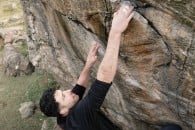












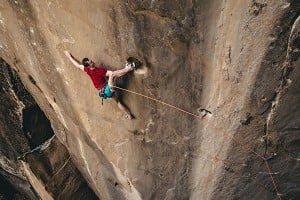
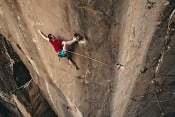



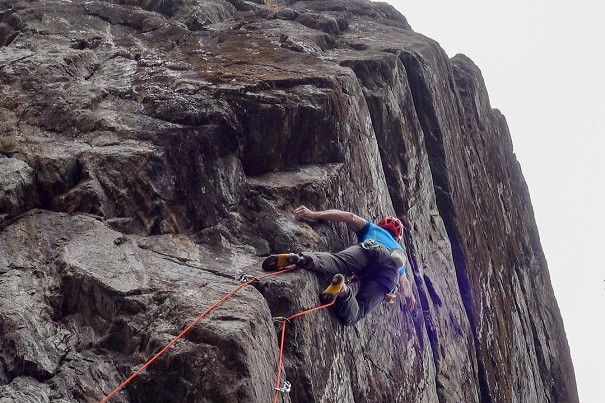
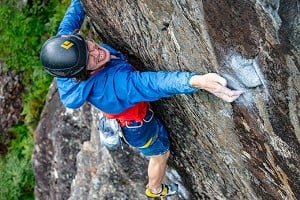
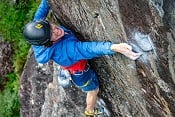
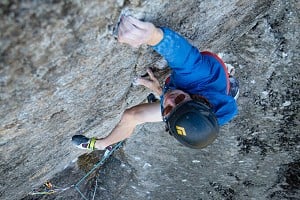
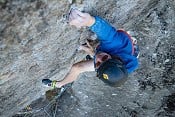
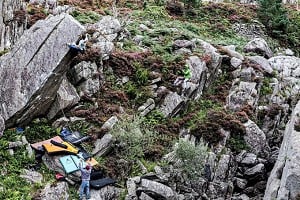
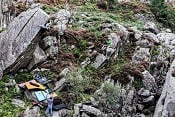

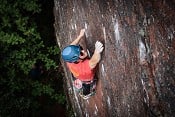

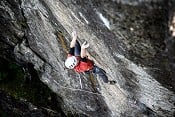

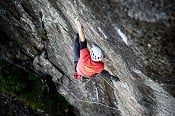
Comments
Well done Mat, persistence paid off in the end. That photo of your damaged piece of gear gives me the horrors though! Good to meet you on the day.
Fantastic. Listened to Mat’s back story on The Nugget, which I found really interesting and motivating. I’m from the Black Country myself so great to see him climbing so well, despite not having many things we take forgranted growing up. Can’t wait to see what he does next.
There was a phrase in there I hadn't heard before. What's a 'knee scum'?
A bad knee bar, where you're just scumming your knee against the rock to take a little weight off.
Thank you, I thought it was something like that. Being old I wasn't sure 😀
But once again, dislikes for asking a question? Bawbags.